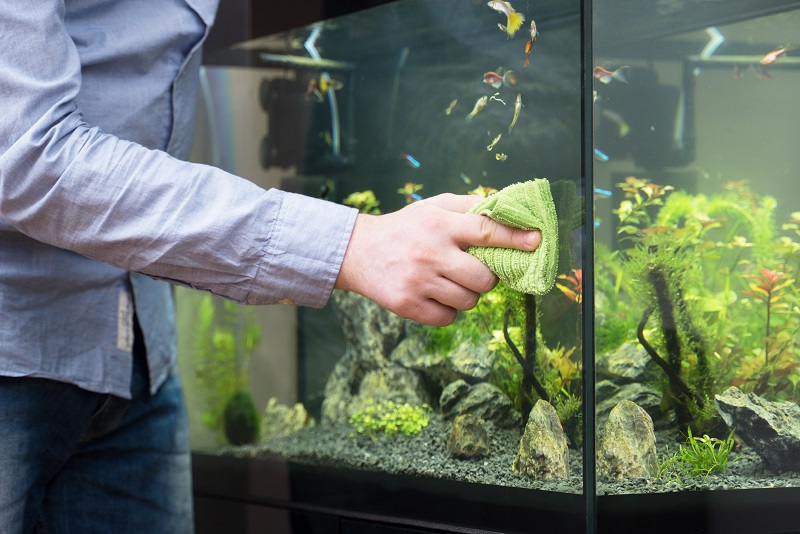A happy and healthy environment for your fish requires consistency. Ask any aquarium enthusiast and you will find that a clean underwater environment is foundational to enjoying a view into a robust aquatic world and keeping your aquatics pets safe.
When we say clean, it is important to note that clean does not align with the same thought process you would use for your home. Always avoid accidentally eradicating the beneficial bacteria colonies that are essential to maintaining a healthy environment for your fishy friends. You never want to completely take apart your tank to clean it, unless some major issue requires a complete restart. Cleaning your fish tank most often means doing simple things on a regular basis.
Before You Start
Before you put your hands in your aquarium for any reason, be sure they are free of lotions, hand sanitizers, cologne or any other material that could be detrimental to your fish. If you wash your hands with antiseptic soap be sure to rinse them thoroughly before putting them in the tank. Fish are very sensitive to these types of chemicals and damage to their slime coat is possible in addition to severe health risks.
Tools To Reduce Your Workload
Items that can make keeping an ideal aquatic environment a breeze include bucket, a gravel vacuum, an algae scraper or scrubber pad (a razor blade can be used if necessary just BE CAREFUL to avoid damaging the glass or silicone) aquarium-friendly glass/acrylic cleaner, paper towels, a filter brush and water conditioner.
Start with the Glass
To start, use your algae scraper or scrubbing pad and give the inside of your aquarium a quick scrub down. Is using pads, be sure to use pads pet shop sell instead of other household cleaning items, as most household cleaning items have a soap or chemical residue that can harm your fish.
Tackling Decorations
When you finish cleaning the aquarium’s internal glass surfaces, move to the decorations and rock matter next. Any artificial plants that are noticeably dirty should be lightly scrubbed with your algae pad or rinsed under warm water in your sink. If your plants look great (meaning your aquarium biological action is doing well) you can skip this one.
Gravel’s Next, But Not Too Much Cleaning Here
You’ll want to clean your gravel as you siphon water out of the aquarium to do your water change. We use a siphon or gravel vacuum to clear away and debris and to refresh the gravel bed. Remember that your gravel is also acting as a huge biological filter for the aquarium, so cleaning it until there is nothing there is not the best course of action. You will quickly figure out how long it takes to get the proper amount of water out of the aquarium to meet your water change parameters. Move the gravel cleaning up and down in the gravel bed to free accumulated waste and food, trying to hit several spots around the tank in the process. If you are changing water weekly, 10% or so should be fine with less vigorous gravel cleaning. If you change water every other week, then shoot for 20 to 25%. Water should be changed at least every other week to maintain optimal conditions for your fish. Always be sure to check that the replacement water has been treated with water conditioner before putting it in the aquarium and that it is the same temperature as the rest of the tank to avoid a rapid change in water temperature in your tank.
Outside the Tank Needs Some Love Too
Turn your attention to the external elements of your fish tank next; including the hood, lights, glass top(s) and the external glass surface. We like to use a vinegar and water mix to ensure that we aren’t unintentionally adding toxins and thus potentially endangering our fish. Most household glass or surface cleaners can be deadly to aquarium inhabitants, even if they are only used on the surface. If some severe cleaning of the top(s), lights, hoods or other external parts is needed, move them to your sink area for cleaning. Be sure they are completely void of any cleaning agents and completely dry before returning them to the tank.
Filter Cleaning At Another Time
For filter cleaning you’ll want to mark your calendar for two weeks from the date that you cleaned the rest of the tank. This is important to allow bacterial colonies to repopulate and help maintain the health of your ecosystem. If you clean your filter at the same time you do the gravel cleaning and water change, you may accidentally trigger an ammonia spike due to a lack of good bacteria, which could have a detrimental effect on your fish’s health. A few thoughts on filter cleaning. If your filter has two filter cartridges, never replace both at one time. Always change one with the other being changed on the next filter cleaning cycle. If you have a spinning wheel in your filter, this is supposed to look dirty. Actually, the dirtier it is the more beneficial bacteria you have working to keep your aquarium in ideal form. If you feel you need to clean the filter intake and outlet tubes, use only aquarium water you have siphoned from the aquarium for this purpose. Avoid any harmful chemicals that could harm your fish. Again, no cleaning agents around the tank for this part of the cleaning process. Remember, water coming out of your tank and going back in to it will pass through the filter, so anything you use to clean it can make its way to the tank.
Lots of folks think water changes are not needed and there are in fact items on the market that “proport to help you reduce them”. We are not a big fan of these items and feel strongly that regular water changes are a very important part of keeping your fish healthy and allowing them to live a long and health-filled life. No other pet spends all of their time living in their own wastewater, help them pull the plug from time to time by doing regular water changes.

